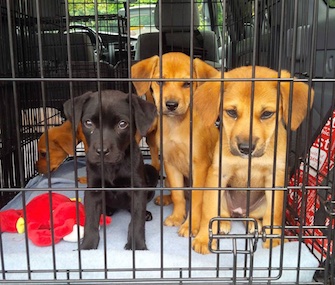Weekend Warriors: The Tough But Rewarding Work of Driving Rescue Dogs to Forever Homes
Published on May 03, 2015

They hit the road on weekends, all over the country: Volunteers load their cars with crates, delivering dogs and cats to areas where they’re more likely to find homes.
Volunteering to do animal transport for your local shelter or rescue can be vital to the animal — and those who do it say it can be an easy way to help.
“I think you would be shocked at the number of vehicles on the road Friday through Sunday that are doing these transports,” says Beth Stevens, who volunteers for several organizations in Maryland, Washington, D.C. and Virginia, including the Lost Dog and Cat Rescue Foundation. She has also volunteered with the Utah-based Best Friends Animal Sanctuary. “It’s happening quietly, every single weekend, all across the country.”
Most of the groups with which Stevens works arrange transportation from rural, southern shelters to metropolitan areas with larger populations, such as Washington, Baltimore and Philadelphia. The animals are escaping the likelihood of being euthanized by arriving at shelters or rescues with a lot more traffic from potential adopters.
“It really is a lifesaving link between where they are — which is certain death — and a happily ever after for them,” says Stevens.
And volunteers are often the ones who provide that essential lifeline.
“We need them to put miles on their car or [go to] random pickup spots,” says Lost Dog’s Colleen Learch, whose last transport ended up becoming her third adopted pet. For people who can’t adopt or foster a pet but still want to help, transporting animals is a perfect way to volunteer.

Loading Them Up
For Lost Dog, Stevens will often meet someone driving a van full of dogs from West Virginia to a point in central Virginia. There, she and other volunteers carefully transfer the assigned animals into their own vehicles, and make sure their records go with them.
The handlers are well aware of any dogs who might be flight risks, and make sure they never have an opportunity to escape in the transfer process.
The volunteers carefully take each dog out to do their duty on a leash, then drive them to their destination. The animals — mostly dogs, but some cats, as well — may be headed to a foster home, shelter, rescue or straight to an animal hospital for treatment.
The crates are stacked into SUVs or even sedans. Stevens once had a car with 20 dogs — a couple of mama dogs and their tiny puppies.
Depending on the group with which you’re working, your volunteering time could take all weekend, or it could be just a few hours. Stevens sometimes works with Rural Shelter Transports, which coordinates weekend relays during which volunteers drive one-hour legs along the transport route.
Chandra Richards, who’s a veterinary technician in Dallas, often volunteers with groups that transport dogs from Texas up to foster-based rescues in Colorado.
“I personally drove a cargo van full of 14 dogs last May, to Colorado, because our normal transport fell through and the dogs weren’t safe staying at the shelter,” Richards says. But, typically the groups with which she works use volunteer transport services like Pilots N Paws or Going Home Animal Rescue and Transport, which is based in Oklahoma. “Between the help of different volunteer transporters, we were moving dogs at least once every two weeks.”

Navigating Tough Logistics
Transport does have its challenges.
“The logistics of it is a challenge and moving animals from car to car and shelter to car, car to vet is tricky sometimes,” Learch says. “We have to do it in a way that is safe for the animal.”
Richards says that in Texas, and where she previously lived in Arkansas, the biggest challenge is often the weather — particularly trying to get to Colorado in the fall or winter.
And, as you can imagine, a carload of dogs can get a little loud… or smelly.
“But, no matter what hardships we face, once everything is figured out and done it is the best feeling in the world,” Richards says. “There is nothing more rewarding than seeing a sad or sick shelter dog go to a loving and happy home.”
You can research the rescues and groups that coordinate transports in your area to see what the time commitments might be like, and which opportunities best fit your lifestyle. Many volunteers find transport to be a better fit for them and their families than other, more traditional animal rescue volunteer opportunities.
“It’s an easy thing to do and it’s a great thing for families to do,” Stevens says. “It’s a great way to bond because you have this long drive down and long drive back, so you have a chance to talk with your kids — and they’re doing this great thing.”
“We get the realities of weekend life, and you might want to volunteer, but you can only do it one Saturday a month,” says Learch. “We never want to say no to a willing set of hands… There’s no shortage of animals who need a ride.”
More on Vetstreet:
- How Two Rescue Dogs Changed a Woman’s Life
- Why Your Dog Always Stares at You
- What Owners of Rescue Dogs Know to Be True
- Get Ready to Have Your Faith in Second Chances Restored
- Dog Behavior Myths: Decoded!





